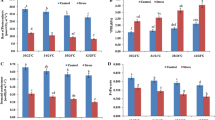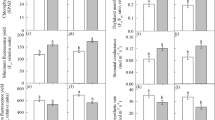Abstract
Effects of high temperature on photosynthesis, and its interaction with water relations in common bean (Phaseolus vulgaris), cowpea (Vigna unguiculata), faba bean (Vicia faba), and five cultivars of field pea (Pisum sativum) were investigated. Responses of all species were compared at 20/15, 30/15, or 30/25 °C day/night, and cowpea and pea were compared at 20/15 and 30/25 °C under well-watered and limited-water conditions. Response of pea to 20/15 and 30/25 °C during flowering was ascertained, and sensitivity of the photosystem of pea and faba bean to 40 °C was determined.
High temperature decreased chlorophyll variable fluorescence (Fv), a measure of injury to photosynthesis, in all species except cowpea, which was highly tolerant. Leaf chlorophyll and most measures of growth were favored by high day temperature but not by high night temperature, and photosynthetic rates were enhanced by high temperatures that increased leaf chlorophyll and nitrogen (N) contents. High temperature diminished growth less than water deficiency and increased water use of all three species but only lowered the water potential in faba bean. Water deficiency generally decreased growth, water use, and water potential more at 30/25 °C than at 20/15 °C. Stress from high temperature during flowering of pea decreased all components of yield at maturity, particularly at nodes that flowered latest. Whole-chain photosynthetic activity in thylakoids of pea, faba bean, and wheat (Triticum aestivum) were equally sensitive to high temperature, suggesting that Photosystem Il was the most labile component. The results show that high temperature affects photosynthesis, growth, and water relations of grain legumes, and sensitivity to the stress differs among species and genotypes.
Similar content being viewed by others
References
Al-Khatib K and Paulsen G M 1990 Photosynthesis and productivity during high-temperature stress of wheat genotypes from major world regions. Crop Sci. 30, 1127–1132.
Berry J A and Börkman O 1980 Photosynthetic response and adaptation to temperature in higher plants. Annu. Rev. Plant Physiol. 31, 491–543.
Bhullar S S and Jenner C F 1986 Effects of temperature on the conversion of sucrose to starch in the developing wheat endosperm. Aust. J. Plant Physiol. 13, 605–615.
Blum A, Ramaiah S, Kanemasu E T and Paulsen G M 1990 Wheat recovery from drought stress at the tillering stage of development. Field Crops Res. 24, 67–85.
Bond D A, Lawes D A, Hawtin G C, Saxena M C and Stephens J H 1985 Faba bean (Vicia faba L.). In Grain Legume Crops. Eds. R J Summerfield and E H Roberts. pp 199–265. Collins Professional and Technical Books, London.
Chen H, Shen Z and Li P H 1982 Adaptability of crop plants to high temperature stress. Crop Sci. 22, 719–725.
Grashoff C and Ververke D R 1991 Effect of pattern of water supply on Vicia faba L. 3. Plant water relations, expansive growth and stomatal reactions. Neth. J. Agric. Sci. 39, 247–262.
Hall A E 1992 Breeding for heat tolerance. Plant Breeding Rev. 10, 129–168.
Hall A E 1993 Physiology and breeding for heat tolerance in cowpea, and comparisons with other crops. In Adaptation of Food Crops to Temperature andWater Stress: Proceedings of an International Symposium, Taiwan, 13–18 August 1992. Ed. C G Kuo. pp 271–284. Asian Vegetable Research and Development Center, Taipai.
Harding S A, Guikema J A and Paulsen G M 1990 Photosynthetic decline from high temperature stress during maturation of wheat. I. Interaction with senescence processes. Plant Physiol. 92, 648–653.
Hellmuth E O 1971 The effect of varying air-CO2 level, leaf temperature and illuminance on the CO2 exchange rate of the dwarf pea Pisum sativum L. var. Meteor. Photosynthetica 5, 190–194.
Krause G H and Weise E 1984 Chlorophyll fluorescence as a tool in plant physiology. II. Interpretation of fluorescence signals. Photosyn. Res. 5, 139–157.
Kuroyanagi T and Paulsen G M 1988 Mediation of high-temperature injury by roots and shoots during reproductive growth of wheat. Plant Cell Environ. 11, 517–523.
Laude H H 1939 Diurnal cycle of heat resistance in plants. Science 89, 556–557.
Mahoney J 1991 Field pea. In New Crops: Agronomy and Potential of Alternative Crop Species. Eds. R S Jessop and R L Wright. pp 53–62. Inkata Press, Melbourne.
Moffatt J M, Sears R G and Paulsen G M 1990 Wheat high temperature tolerance during reproductive growth. I. Evaluation by chlorophyll fluorescence. Crop Sci. 30, 881–885.
Nielson C L and Hall A E 1985 Responses of cowpea (Vigna unguiculata (L.) Walp.) in the field to high night temperature during flowering. II. Plant responses. Field Crop Res. 10, 181–196.
Pate J S 1977 The pea as a crop plant. In The Physiology of the Garden Pea. Eds. J F Sutcliffe and J S Pate. pp 469–484 Academic Press, London.
Pate J S and Flinn A M 1977 Fruit and seed development. In The Physiology of the Garden Pea. Eds. J F Sutcliffe and J S Pate. pp 431–468 Academic Press, London.
Paulsen G M 1994 High temperature responses of crop plants. In Physiology and Determination of Crop Yield. Eds. K J Boote, J M Bennett, T R Sinclair, and G M Paulsen. pp 365–389. ASA-CSSA-SSSA, Madison, WI.
Rao R C N and Wright G C 1994 Stability of the relationship between specific leaf area and carbon isotope discrimination across environments in peanut. Crop Sci. 34, 98–103.
Ridge P E and Pye D L 1985 The effects of temperature and frost at flowering on the yield of peas grown in a Mediterranean environment. Field Crops Res. 12, 339–346.
Sayed O H, Emes M J, Earnshaw M J, and Butler R D 1989 Photosynthetic responses of different varieties of wheat to high temperature. I. Effect of growth temperature on development and photosynthetic performance. J. Exp. Bot. 40, 625–631.
Stanfield B Ormrod D P and Fletcher H F 1966 Response of peas to environment. II. Effects of temperature in controlled environment cabinets. Can. J. Plant Sci. 46, 195–203.
Steel R G D and Torrey J H 1960 Principles and procedures of statistics with special reference to the biological sciences. McGraw-Hill Book Co. Inc., New York.
Udomprasert N Li P H Davis D W and Markhart III A H 1995 Effects of root temperatures on leaf gas exchange and growth at high air temperature in Phaseolus acutifolius and Phaseolus vulgaris. Crop Sci. 35, 490–495.
Williams W P Sen A and Fork D C 1984 Selective photobleaching of PSl-related chlorophylls in heat-stressed pea chloroplasts. Photosyn. Res. 10, 72–92.
Author information
Authors and Affiliations
Rights and permissions
About this article
Cite this article
McDonald, G., Paulsen, G. High temperature effects on photosynthesis and water relations of grain legumes. Plant and Soil 196, 47–58 (1997). https://doi.org/10.1023/A:1004249200050
Issue Date:
DOI: https://doi.org/10.1023/A:1004249200050




